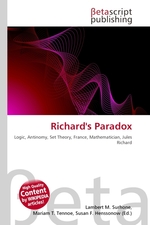Richards Paradox
Lambert M. Surhone, Mariam T. Tennoe, Susan F. Henssonow
бумажная книга
High Quality Content by WIKIPEDIA articles! In logic, Richard's paradox is a semantical antinomy in set theory and natural language first described by the French mathematician Jules Richard in 1905. Today, the paradox is ordinarily used in order to motivate the importance of carefully distinguishing between mathematics and metamathematics. The paradox was also a motivation in the development of predicative mathematics.The original statement of the paradox, due to Richard (1905), has a relation to Cantor's diagonal argument on the uncountability of the set of real numbers. The paradox begins with the observation that certain expressions in English unambiguously define real numbers, while other expressions in English do not. For example, "The real number whose integer part is 17 and whose nth decimal place is 0 if n is even and 1 if n is odd" defines the real number 17.1010101..., while the phrase "London is in England" does not.
Данное издание не является оригинальным. Книга печатается по технологии принт-он-деманд после получения заказа.


